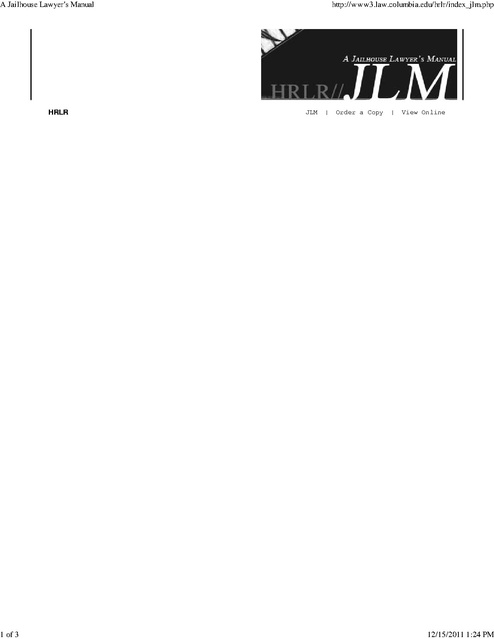Columbia Law Website Description of Jailhouse Lawyers Manual 2011
Download original document:

Document text

Document text
This text is machine-read, and may contain errors. Check the original document to verify accuracy.
A Jailhouse Lawyer's Manual 1 of 3 HRLR http://www3.law.columbia.edu/hrlr/index_jlm.php JLM | Order a Copy | View Online 12/15/2011 1:24 PM A Jailhouse Lawyer's Manual 2 of 3 http://www3.law.columbia.edu/hrlr/index_jlm.php A J a ilho u s e La wyer 's Ma nu a l A Jailhouse Lawyer's Manual (JLM) is a handbook of legal rights and procedures designed for use by people in prison. Since publication of the First Edition in 1978, tens of thousands of prisoners in institutions across the country have used A Jailhouse Lawyer’s Manual to exercise their legal rights. Prisoners are often indigent and lack access to legal counsel while incarcerated. The JLM informs prisoners of their legal rights and instructs them about how to secure these rights through the judicial process, clearly explaining legal research techniques and how to read legal documents. Prisoners may use the JLM to address specific problems related to their treatment in prison, or to attack their unfair convictions or sentences. To date, more than two hundred correctional facilities across the United States have ordered the JLM, in large part due to the Supreme Court's H O W TO G E T A J A I L H O U S E L AW Y E R 'S M A N U A L View Online: You can download the entire Jailhouse Lawyer’s Manual for free and read it on a computer or print it yourself. The online JLM is divided into chapters for easier downloading. Order a Copy: You can also purchase a printed book. We try to keep the price as low as possible for prisoners and their family members. Note that the JLM is not available for purchase anywhere on Columbia University's campus. decision in Bounds v. Smith, 430 U.S. 817 (1977). Bounds requires states to provide prisoners with meaningful access to the judicial system, either through legal assistance programs or adequate law libraries. This influential opinion, written by Justice Marshall, and cited in over three hundred opinions in thirty-three states and eleven federal circuits, has had a dramatic impact on the ability of prisoners to pursue their legal rights while in prison. The JLM can assist prisoners in effectively using the resources available to them in their prison law libraries. Many prison administrators have ordered the JLM as part of their efforts to build adequate law libraries, discovering that prisoners find the book easy to use and relevant to issues that concern them. The Ninth Edition of the JLM, published in 2011, contains chapters covering a wide variety of topics that are listed and available for download in PDF format here. The JLM also includes a directory of legal and social services for prisoners around the country. With the needs of prisoners across the country in mind, the Columbia Human Rights Law Review has endeavored, to the extent feasible, to make the Ninth Edition of the JLM useful to all prisoners without regard to where they are incarcerated. The information on federal actions will be helpful to a prisoner in a federal prison, or pursuing federal claims, no matter where the prisoner is located. The law, procedures and forms relating to state actions vary from state to state, however. Where possible, we provide information that is generally applicable, although we often use New York forms and procedures for specific illustrations. We regret that the size and scope of the book prevent us from providing forms and specific procedural information for all states. Nevertheless, prisoners outside New York will find the JLM a valuable research tool. In the past few years, the United States Congress has created more obstacles to keep prisoners out of the courthouse. These new laws include the Prison Litigation Reform Act, which severely restricts prisoners’ ability to bring civil lawsuits, as well as their ability to be represented by an attorney. Similarly, the Anti-Terrorism and Effective Death Penalty Act sharply limits the availability of the writ of habeas 12/15/2011 1:24 PM A Jailhouse Lawyer's Manual 3 of 3 http://www3.law.columbia.edu/hrlr/index_jlm.php corpus, used by prisoners for centuries to challenge unlawful confinement. Finally, the Illegal Immigration Reform and Immigrant Responsibility Act denied judicial review in many circumstances to immigrants that are ordered deported because of past criminal activity. The Ninth Edition provides up-to-date information about changes in the law. In addition to the JLM, the HRLR published an English-language Immigration and Consular Access Supplement for the first time in April, 2007. In May, 2008, a Spanish-language Immigration and Consular Access Supplement also became available available for purchase. A Spanish-language JLM (the "SJLM") is available to provide an accessible resource for those prisoners who speak only Spanish. The SJLM was translated from the Fifth Edition of the English-language JLM. So, readers of this resource should know that some of the law included in the SJLM may be out of date and may not reflect recent important legal changes. SJLM readers must supplement this resource with their own research. We anticipate putting out a new edition of the SJLM in the coming two years. An important part of managing and revising the JLM is responding to the heavy volume of mail we receive from prisoners. We thank the many jailhouse lawyers whose helpful comments have contributed to improvements to in the JLM. We ask that readers of the manual continue to share with us their ideas and comments. In short, we hope the JLM will help prisoners protect their rights under the law. We urge dedicated jailhouse lawyers to continue to stand up for their rights and enforce their humanity against those who would try to deny it. Remember—the JLM stands behind you! Last updated April 2011 Login © Columbia University, 2000-2011. 12/15/2011 1:24 PM

